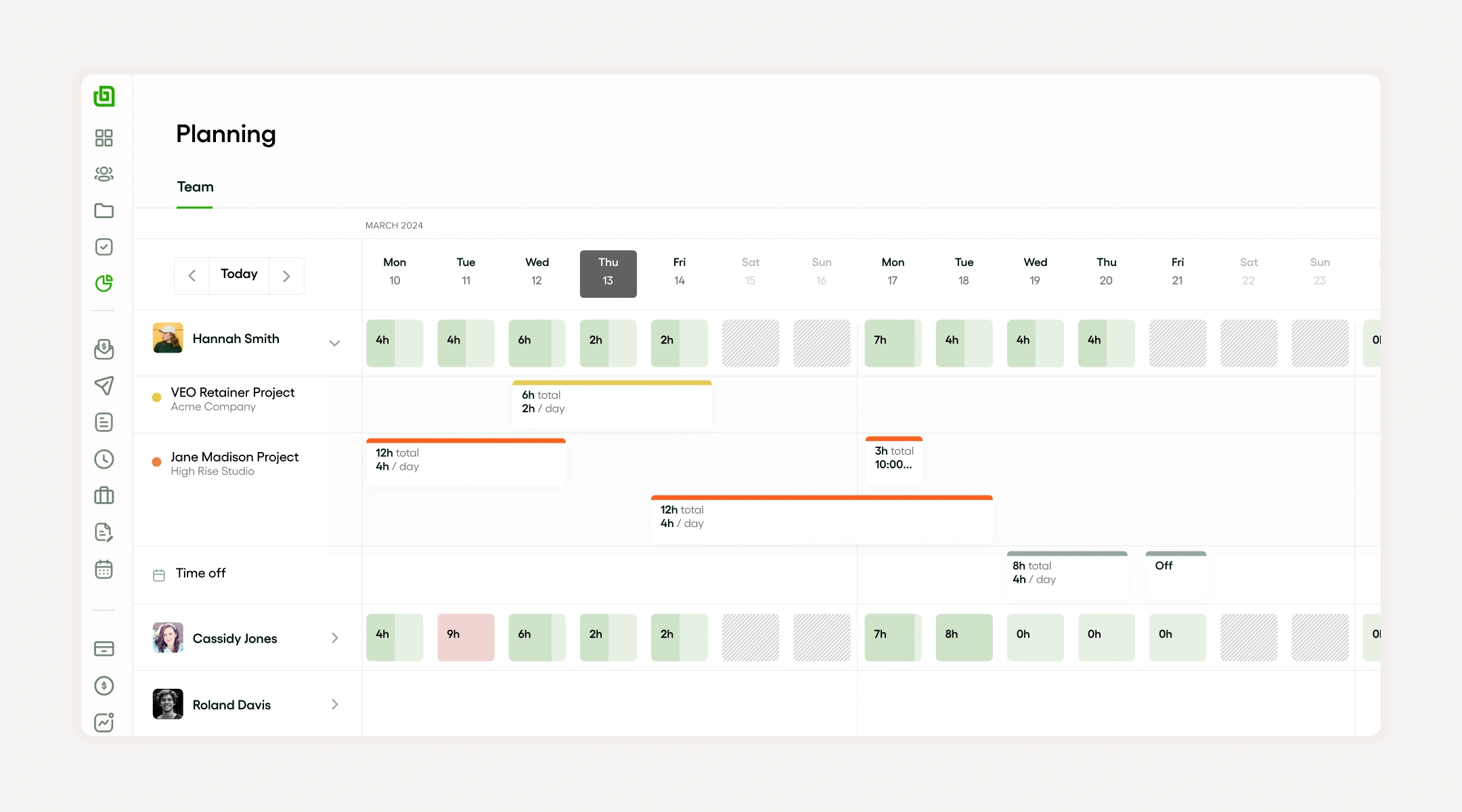The 5 biggest hurdles small internet marketing agencies face include communication barriers, talent acquisition and retention, budgeting challenges, and adopting new technologies. Effective communication with clients and within teams is crucial to maintaining trust and productivity. Agencies must also focus on attracting and retaining skilled talent to remain competitive. Budgeting requires careful planning to ensure resources are allocated efficiently, while staying updated with technological advancements is essential for maintaining a competitive edge. By addressing these challenges with strategic solutions, agencies can enhance their productivity and ensure long-term success in a rapidly evolving digital landscape.
1. Communication barriers
This is one of the most common problems modern companies have. It can surface in a few different ways, but each will ultimately affect the company’s productivity and profitability.
Client communications
First off, there’s ineffective communication between the agency teams and the client. It’s one of the quickest ways to lose a client’s trust and, by extension, the option of a long-term business relationship to give you a steady income.
Communicating with clients might not be everyone’s cup of tea on your team, but it’s something that your company must do to ensure the projects stay on track. Ultimately, it’s a vital part of being in an agency.
Even if you are able to check in with a client frequently, you might run into an issue where one of the sides keeps repeating the same requirements that are not being met. This can pose short-term issues but indicates a deeper problem of not retaining or acting upon the information being fed to the team.
This is where a customer relationship management tool shines. It allows you to keep track of important client details all in one place and disseminate important information to the rest of the team. Your team can use it to collect all data they have on the client and minimize the overlap between the information presented during meetings.

Enhance Client Communications with Bonsai's Client Portal
To overcome communication barriers and build strong relationships with clients, it's important to keep track of every interaction. Bonsai's client portal helps you do just that. It acts as a central hub where all your client communication is stored.
This transparency helps build trust and strengthens your relationships with clients over time.
See how Bonsai can transform your client communication and build lasting relationships.

Internal communications
Some of the biggest issues you might face while managing a business are communicating with other team members and creating a culture that balances productivity, professionalism, and trust. The range of issues has skyrocketed in recent years, especially with rapid shifts in how younger generations tackle mental health and remote working.
According to a study published by Harvard Business Review, half of Millenials and three-quarters of Gen Z-ers left their roles due to mental health problems. It found that companies seldom accept that employees might have a problem and perpetuate the stigma that mental health is a wholly personal issue that shouldn’t affect work performance.
Additionally, one of the key turning points in digital agencies has been the widespread adoption of remote work courtesy of the COVID-19 pandemic. The impact of remote work on productivity and team cohesiveness has been brought up repeatedly by various industry outlets. However, there’s little consensus and often contrasting stances on how the practice should be tracked.
Somewhat connected to the second point is the increasing practice of hiring foreign freelancers due to a wider pool of talent abroad that usually demands a lower salary. The pros and cons of hiring freelancers are a separate topic. But one of the main issues many companies have is integrating freelancers into the team – often with mixed success.
Some managers fall for the fallacy that they should closely monitor and control their freelancers to ensure “they’re getting their money’s worth.” However, this usually only works to build resentment since freelancers turn to their way of working partly to explicitly avoid that kind of managerial system.
The solutions for these problems are multiple, but they always start from the very top of the corporate ladder. The upper management must create communication channels with the rest of the team that allows for sharing experiences and building trust with the team.

If you have particular problems with a few members of the team or freelancers, start slow and establish a rapport. Communicate in writing as much as possible, which allows you to retain the information better and creates an easy way to recall the specifics of the conversation. If that’s not possible, keep detailed notes on team members’ preferences in communication. This will also help you create effective and beneficial policies on how to handle common problems.
Finally, make sure to balance your team’s workload carefully through smart task management. You can create a more manageable and fulfilling workload by having a clear overview of what your team is doing and what projects they’re most successful with.
2. Obtaining new talent
If you’re running a digital agency, the most versatile and reliable working method is fully remote work. It also allows you to tap into the largest possible pool of candidates. However, the opposite is also true. Since many agencies allow for fully remote work, the best candidates have their pick of agencies to choose from. Consequently, attracting qualified talent turns out to be one of the most common agency challenges these days.
There are a few different solutions you can combine for this particular problem. But first, you need to understand that it’s unlikely that the perfect candidate will land at your doorstep whenever you have a vacant position on the team. In most cases, you’ll need to dredge through piles of unqualified or barely qualified candidates. You’ll find the best person at the time and try to reshape them into the best person for the job.
The first thing you need to do is ensure a positive application experience. Detail the requirements, responsibilities, and expectations of the role clearly, using simple terms and providing a concise view of the daily tasks included in the position. Use straightforward questions that don’t leave much room for interpretation to remove applicants who clearly don’t fit the intended employee profile.
If your company is the one doing the recruiting, you need to keep in mind that the most qualified and popular candidates likely have multiple opportunities open to them at any time. You need to research what motivates them and create a unique value proposition that will make you stand out from the other companies. This can range from benefits packages to flexible work hours, but it will usually pay off to stay open to compromises.

You may also be tempted to use an Applicant Tracking System (ATS) to expedite the removal of unqualified candidates from the talent pool. It can be an excellent way to streamline hiring, with some surveys reporting that around 80% of users are happy with how the tool performs. However, beware of over-relying on software to do your work for you, especially if you use AI-powered ATS tools.
If you plan to use an AI-based ATS, make sure to provide a clear job description that allows applicants to pick it apart and submit applications that the ATS system won’t gloss over. This can be doubly important if you want experienced personnel who haven’t been on the job market in a long time. With the relatively recent additions of ATS systems, it can also be worthwhile to tinker with the system to ensure it’s not rejecting candidates who’d be a good fit because their application unintentionally lacked a keyword.
Finally, make sure to build a strong brand and relatable culture in the company and to clearly set out your expectations for further communication. Ghosting has become one of the more significant problems in the recruitment industry, but it’s widespread on both ends. Make sure not to sour your reputation by forgetting to send crucial emails and keep track of the recruitment pipeline.
3. Retaining quality talent
Even if you manage to hire the most competent person from the hundreds of applications you receive, you’re now facing the increasing issue of retaining them for years to come. A study by Promethean showcased that employee retention is one of the biggest agency challenges that has only grown worse over the years.
This is partly due to increased salary expectations and the proliferation of “buzzwordy” job titles that don’t have a clear list of responsibilities.
A part of the solution relies on establishing proper communication (see the “communication” section above). However, you also need to evaluate your key team members and ensure they’re the right fit for the company. In some cases, a new team member might seem like an operational fit, but they clash with the team’s culture or existing process pipelines too much to be worth keeping.
In those cases, it might be more worthwhile to start with new candidates and create more culture-bound recruitment processes to ensure new hires are better fits.
Additionally, communicate with the team members and promote a transparent compensation structure. It will reduce the feeling of lack of value in the team and ensure that everyone on the team is on the same side of salary negotiations.
What you can also try are more flexible work models and better-organized reward programs. Findings by a four-day workweek pilot in the UK suggest that more than 92% of companies believed the new working schedule positively impacted employee performance, productivity, and morale. For reward programs, create game-like systems and badges for completing training programs or participating in team-wide activities.

Finally, you have to ensure you keep your employees motivated. In some cases, this means rewarding achievements and out-of-the-box thinking. In others, you need to ensure that the employees are assigned to projects that play well not only to their skillset but also to their personal or professional interests. Lastly, it’s important to understand that motivation sometimes must come from within the employees themselves. This falls back on ensuring there are proper communication channels to figure out what makes the employee “tick” and how that can play into your hand.
4. Finding a niche and value proposition
There are a few key aspects of creating a business plan that will ensure that the company will grow.
One is in finding the right niche for your products and services. This means carefully researching the audience to identify the right client persona that is more likely to need your products. But it also means tailoring the services you provide to a smaller share of the audience.
While this might sound limiting, it allows you to create more specific and all-rounded solutions that cater to your niche better than catch-all agencies. This gives you more upselling opportunities and gives you a chance to prove that you’re absolutely vital to your audience. Ultimately, it ensures that you can create a long-term business relationship and increase the expected customer lifetime value (CLV).
Secondly, you need to specialize and create your unique value proposition. What this means is that you need to find the exact combination of branding and selling points to separate yourself from the crowd. It will allow you to create a more personalized bond with your customers and get them in the right mindset that your company is the right fit for their needs.
5. Getting new clients
This is perhaps one of the most common reasons new agencies have trouble expanding beyond the initial months in business. In that umbrella of problems, one usually stands out: determining whether a client will be a net positive for the company.
Of course, clients will inevitably create income for your company. However, that’s not going to lead you to growth directly. What you need to determine is how profitable a client is going to be for your company.
Not carefully choosing your clients can lead to a few scenarios:
- The team is incapable of handling the client’s demands. Perhaps your team is not skilled or large enough to handle the additional work required for the client while also taking on your other clients. It could lead to cut corners or failure to meet deadlines. Either way, the client is not happy with the work and doesn’t use your company further.
- The client doesn’t find your work satisfactory. This could be due to a number of reasons, from impossible expectations to a vastly different opinion on the processes behind the project. In some cases, the client might refuse to pay for the service, wasting dozens or even hundreds of person-hours you invested into them.
- The scope of the work outweighs the cost. A lack of communication during the initial briefing can lead to the client demanding more and more work. Without an agency contract that outlines clear stipulations for payment for additional work, you may be sinking more time into work for which you’re not being paid.
In either case, your company has lost time with a client that was unsuitable from the start, the client has probably created a false image of your expertise in their head and might leave a bad review, and you haven’t turned a profit.
Solving this requires setting up a client relationship management system and carefully tracking the scope and costs associated with onboarding new clients and maintaining projects. It will allow you to see which clients have the highest expected lifetime value or whether they are worth the resources you invest into maintaining a business relationship.
6. Budget
Understanding the specific challenges an agency faces is critical, one such challenge is creating a competent pricing strategy. To overcome this, you may want to read our previous article on effective pricing strategies for agencies. This will provide you with practical methods to improve your pricing model and enhance agency profitability.
For the past few years, the economy has been in a rough state. Increasing costs of living, lower-than-expected economic growth, and the increased pressure that salaries have put on operating costs have forced some businesses to reconsider hiring new people or reevaluate the profitability of their projects.
Additionally, the growing competition has created pricing pressure, making some companies try to undersell their services to stay afloat and remain profitable.
However, one area that’s difficult to manage is estimating the cost of work. If your creative agency is primarily trying to solve novel problems for customers, you likely don’t have a benchmark to estimate how long the project will take or how to bill the client. This can lead to undervaluing the agency’s work and creating lower income than expected.

This can be solved by combining two tools. First, you need accurate and centralized bookkeeping and invoicing software. By having a broad overview of your income and expenses, you can create more accurate reports of your profits and keep an eye on project fluctuations between months.
Second, you need to use time-tracking and project-management tools. You can more accurately calculate your project fee or the person-hours required for invoicing by tracking the project phase timeline and the personnel involved at each juncture.
You should also look into solidifying your pricing model and ensuring that you’re charging for additional work appropriately. For example, over 64% of digital marketing agencies listed “landing pages” as something warranting a separate fee from traditional long-term work.
7. Adopting new technologies and software
Agency-related challenges can be difficult to manage, but they're not insurmountable. For instance, familiarizing yourself with common project management implementation challenges can help you effectively overcome these obstacles. By understanding these challenges, you can develop tailored solutions to ensure your agency thrives.
As a digital agency, you must be at the forefront of innovation, and you need to use the best available software to manage your own company before you can help someone else.
If you can, try to streamline your management tools to the bare minimum. This doesn’t mean you have to give up vital services such as communications or bookkeeping.
What you can do is find a centralized agency management solution that solves multiple problems at once, such as Bonsai. By combining project management, client relationship management and financial management software in one, you can easily keep track of nearly every aspect of your business.

It ensures that your team members have a quick way to check project milestones, schedules, and specific details on the project that can be found in client profiles to help them meet customer demands.
8. Effective collaboration and outsourcing
A small agency might not have all the tools and talent at its disposal to take care of all of its clients’ needs. It may be tempting to try and cobble solutions from existing capabilities that barely satisfy a client’s demand. However, it will likely be better to use an outside freelancer or consultant to cover your weak points.
What you need to ensure is that the freelancer can collaborate with the rest of your team and create valuable solutions for your company. Beyond making sure they’re a good culture fit—regardless that they might be working with you for a single project—you need to compensate them for their time properly.
That’s where Bonsai’s collaboration tools come into action. You can assign subcontractors and freelancers limited access to your project pipelines, giving them direct insight into vital project details. Additionally, the collaborator can track the time spent on their tasks and bill you directly for their work.
Try Bonsai's Task Management Tools for Effective Collaboration
Coordinating a team requires having clear task assignments and deadlines. Bonsai's task management tools help you with this. You can easily track tasks to ensure both you and your team know their responsibilities and deadlines.
The result? You run your projects smoothly
This way you can assign tasks to your team, plan your week, and see how your projects are progressing.
Deliver work on time with Bonsai's task management tool
See progress with the Kanban view: Get a clear view of how tasks are progressing on a board.
Track time with integrated timers: Start timers from your task list or assign tasks with pre-set hours.

Collaborate with your team: Invite team members to your projects, assign tasks, and add comments.
Stay focused on priorities: Set deadlines, track tasks, set priorities, and keep your team efficient.
Manage your team and resources: Let your team track time spent on their assigned tasks.

Track budget & profitability: Collaborate with others on a project and manage tasks and time tracking.








